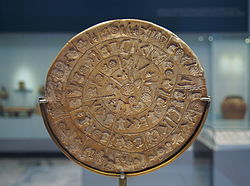


Many people have claimed to have deciphered the Phaistos Disc.
The claims may be categorized into linguistic decipherments, identifying the language of the inscription, and non-linguistic decipherments. A purely ideographical reading is semantic but not linguistic in the strict sense: While a semantic decipherment may reveal the intended meaning of the symbols in the inscription, it would not allow us to identify the underlying words or their language.
A large part of the claims are clearly pseudoscientific, if not bordering on the esoteric. Linguists are doubtful whether the inscription is sufficiently long to be unambiguously interpreted. It is possible that one of these decipherments is correct, and that, without further material in the same script, we will never know which. Mainstream consensus tends towards the assumption of a syllabic script, possibly mixed with ideogram, like the known scripts of the epoch (Egyptian hieroglyphs, Anatolian hieroglyphs, Linear B).
Some approaches attempt to establish a connection with known scripts, either the roughly contemporary Cretan hieroglyphs or Linear A native to Crete, or Egyptian or Anatolian hieroglyphics. Solutions postulating an independent Aegean script have also been proposed.